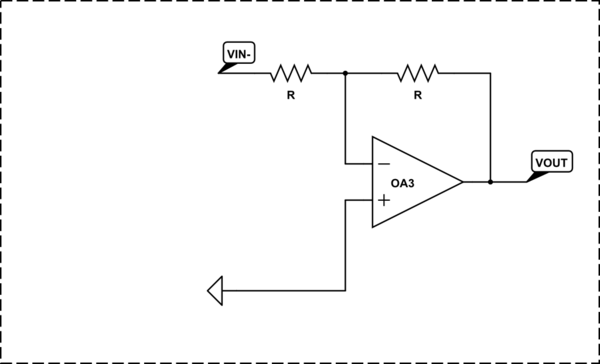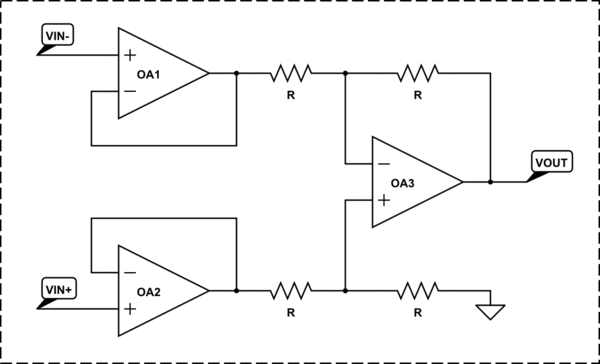Your question is "philosophical" and therefore requires a "philosophical" answer:-) You are actually asking, "What is the idea behind the classic op-amp instrumentation amplifier?" The best way to show it is by reinventing the circuit step by step. Here is my "building scenario"...
Step 1: Single-ended amplifier
It is assumed the two basic circuits of op-amp amplifiers with negative feedback have already been "invented":
- Non-inverting amplifier

simulate this circuit – Schematic created using CircuitLab
- Inverting amplifier

simulate this circuit
How this happened is another (no less interesting) story, but now let's just mention the trick with which this was done - in the basic circuits of a follower (K = 1) and inverter (K = -1) an attenuation is introduced in the negative feedback. Compensating for it, they have become amplifiers.
Step 2: Imperfect differential amplifier
We need a device that amplifies the difference between two input voltages. So we start looking for a second input with the opposite effect in each of the two configurations. We have two options to do so:
- In the circuit of the non-inverting amplifier we can insert the second source between the input (left) resistor and ground. Thus we obtain another but inverting input.

simulate this circuit
- In the circuit of the inverting amplifier we can insert the second source between the non-inverting input and ground. Now we obtain another but non-inverting input.

simulate this circuit
The result is the same "differential" configuration.
Step 3: Ordinary differential amplifier
But there is a problem - the gain of the non-inverting input is one unit higher than the gain of the inverting input (this is also interesting to explain... but let's not be now). We start looking for a way to equalize the gain of the two inputs. We have two options:
- We can decrease the gain of the non-inverting input by one through a voltage divider. Thus we get the classic 4-resistor circuit of a simple differential amplifier (shown on the right side of the OP's circuit).

simulate this circuit
- We can increase the gain of the inverting input by one through an additional non-inverting amplifier and we get Spehro's circuit solution.

simulate this circuit
At the time, they chose the first solution for obvious reasons - not only because it is more beautiful and symmetrical:-) but simply because operational amplifiers were expensive. Let's then follow them...
Step 4: Improved differential amplifier
But the simple 4-resistor differential amplifier has a significant drawback - low input resistance (in addition, it is different for both inputs). The worst thing in this case is that the difference in the internal resistances of the input sources unbalances the circuit.
The first thought that comes to mind to solve this problem, of course, is to put op-amp voltage followers before the circuit inputs.

simulate this circuit
This solves the input resistance problem... but a new problem arises when we need more significant gain - the ability of the second stage to amplify is limited and we must make the first stage also amplify.
Step 5: Instrumentation amplifier prototype
The straightforward solution is to make the input followers amplify, ie, to turn them into non-inverting amplifiers by inserting voltage dividers between the op-amp outputs and inverting inputs.

simulate this circuit
However, a new problem arises - the common-mode gain. Simply put, we would like the input stage to amplify the input voltages when they change in the opposite direction and not to amplify them when they change in the same direction with the same rate. How do we do it?
Step 6: Instrumentation amplifier
The famous "long-tailed pair" can help us. For this purpose, we simply combine the two lower resistors Rg/2 of the voltage dividers into one Rg = Rg/2 + Rg/2 (R1 in the OP's circuit).

simulate this circuit
Now the circuit has a different behavior depending on how we change the input voltages:
- Differential mode. When the voltages change in the opposite direction, the so-called "virtual ground" (zero voltage point) appears in the middle point inside Rg (as though it is connected to ground). The gain is maximum since the input op-amp stages act as non-inverting amplifiers (the same as above). You can "see" this "magic" point if you "open" Rg and touch the resistive film by the voltmeter probe... or you can just imagine the voltage distribution along Rg resistive film. I call this picture "voltage diagram" (I have considered in detail this visualization technique in one of my Codidact papers). See, for example, the picture below that I created in 2008 for my Wikibooks story about Ohm's experiment:

- Common mode. If the input voltages change in the same direction with the same rate, the voltages of all op-amp inputs, all points inside Rg (including the middle point) and both op-amp outputs change in the same way. As a result, the input op-amp stages act as voltage followers (K = 1). See another picture of mine extracted from the Wikibooks story mentioned above:

You can see "live" voltage diagrams of these modes in the movie from my personal Google Photos. The computerized laboratory experiment shown in the movie is described in the same Wikibooks story.
This was my story about the famous op-amp instrumentation amplifier. See also my answer to a similar question.
 Just like this one, having an inverting gain of 100 and having high impedance inputs, while consisting of fewer components. What functionality am I losing when sacrificing a differential configuration over this one.
Just like this one, having an inverting gain of 100 and having high impedance inputs, while consisting of fewer components. What functionality am I losing when sacrificing a differential configuration over this one.














